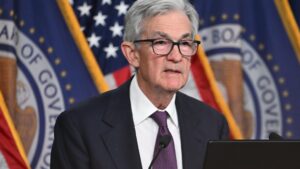The Federal Reserve’s Latest Rate Cuts: What You Need to Know
The Federal Reserve recently made headlines by lowering its key interest rate by 25 basis points, marking the third consecutive cut in recent months. This pivotal decision has sent ripples through the financial markets, prompting a closer look at what this means for consumers, investors, and the economy as a whole.
Understanding the Rate Cut
On Wednesday, the Federal Open Market Committee announced the reduction of its overnight borrowing rate to a target range of 4.25% to 4.5%. This drop brings rates back to their December 2022 levels, before a series of hikes had fueled inflation concerns. While the rate cut itself was expected by many market analysts, the core conversation revolved around the Fed’s future trajectory in a climate of persistent inflation and robust economic growth.
What Lies Ahead?
In a notable shift, the Fed’s members communicated that they may only proceed with two more rate cuts in 2025, trimming previous projections made in September. By signaling cautious optimism, the committee acknowledges that economic conditions are complex, with inflation consistently surpassing the 2% target and growth forecasts looking positive.
Chair Jerome Powell emphasized the cautious approach during a post-meeting press conference: “With today’s action, we have lowered our policy rate by a full percentage point from its peak, and our policy stance is now significantly less restrictive.” This adjustment suggests that the Fed is prioritizing stability over aggressive cuts, aiming to avoid an economic slowdown.
Market Reactions
In the wake of the announcement, the markets reacted predictably—stocks fell while Treasury yields rose. Futures pricing indicated an adjustment in expectations, reflecting a belief that further cuts may not materialize as quickly as previously thought. The Fed’s dot plot, which illustrates the projected path of interest rates, reflects a more conservative outlook than months prior.
Economic Outlook and Inflation Concerns
The Fed’s decision comes against a backdrop of mixed economic signals. The committee recently increased its 2024 GDP growth projection to 2.5%, a notable rise from earlier expectations. Despite this, a slowdown is anticipated in subsequent years, reinforcing the need for a balanced approach to policy adjustments.
Current inflation rates remain stubbornly above the Fed’s target, with headline and core inflation estimates rising to 2.4% and 2.8%, respectively. Even as the economy shows signs of resilience, Powell reiterated the Fed’s commitment to maintaining a careful balance: “We need to take our time, not rush and make a very careful assessment.”
Navigating a New Financial Landscape
As financial landscapes fluctuate, staying informed can empower investors and consumers. Here at Extreme Investor Network, we believe in the importance of understanding these changes to make smarter financial choices. Whether you’re considering mortgage adjustments, stock market investments, or personal financial planning, it’s crucial to factor in interest rate trends and the overall economic environment.
Conclusion: A More Cautious Fed
The Federal Reserve’s recent decisions underscore a broader strategy focused on thoughtful management of monetary policy. As we move forward, the interplay between inflation control and economic growth will likely define the Fed’s actions in the coming years.
For those looking to navigate this uncertain terrain, our team at Extreme Investor Network is dedicated to providing you with timely insights and expert analysis to help inform your investment decisions. Stay tuned for more updates and strategies to optimize your financial wellbeing in an evolving economic landscape.

